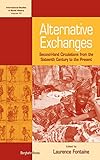Alternative Exchanges : Second-Hand Circulations from the Sixteenth Century to the Present / ed. by Laurence Fontaine.
Material type: TextSeries: International Studies in Social History ; 10Publisher: New York ; Oxford : Berghahn Books, [2008]Copyright date: ©2008Description: 1 online resource (280 p.)Content type:
TextSeries: International Studies in Social History ; 10Publisher: New York ; Oxford : Berghahn Books, [2008]Copyright date: ©2008Description: 1 online resource (280 p.)Content type: - 9781845452452
- 9780857450081
- 381 22/eng
- HF5482
- online - DeGruyter
| Item type | Current library | Call number | URL | Status | Notes | Barcode | |
|---|---|---|---|---|---|---|---|
 eBook
eBook
|
Biblioteca "Angelicum" Pont. Univ. S.Tommaso d'Aquino Nuvola online | online - DeGruyter (Browse shelf(Opens below)) | Online access | Not for loan (Accesso limitato) | Accesso per gli utenti autorizzati / Access for authorized users | (dgr)9780857450081 |
Frontmatter -- CONTENTS -- LIST OF FIGURES AND TABLES -- ACKNOWLEDGEMENTS -- INTRODUCTION -- 1 SECOND-HAND DEALERS IN THE EARLY MODERN LOW COUNTRIES. INSTITUTIONS, MARKETS AND PRACTICES -- 2 USING THINGS AS MONEY. AN EXAMPLE FROM LATE RENAISSANCE ROME -- 3 PROSTITUTION AND THE CIRCULATION OF SECOND-HAND GOODS IN EARLY MODERN ROME -- 4 “THE MAGAZINE OF ALL THEIR PILLAGING” ARMIES AS SITES OF SECOND-HAND EXCHANGES DURING THE FRENCH WARS OF RELIGION -- 5 THE EXCHANGE OF SECOND-HAND GOODS BETWEEN SURVIVAL STRATEGIES AND “BUSINESS” IN EIGHTEENTH-CENTURY PARIS -- 6 USES OF THE USED. THE CONVENTIONS OF RENEWING AND EXCHANGING GOODS IN FRENCH PROVINCIAL ARISTOCRACY -- 7 THE SCOPE AND STRUCTURE OF THE NINETEENTH-CENTURY SECOND-HAND TRADE IN THE PARISIAN CLOTHES MARKET -- 8 “WHAT GOES ’ROUND COMES ’ROUND”. SECOND-HAND CLOTHING, FURNITURE AND TOOLS IN WORKING-CLASS LIVES IN THE INTERWAR USA -- 9 MOVING ON. OVERLOOKED ASPECTS OF MODERN COLLECTING -- 10 THE SECOND-HAND CAR MARKET AS A FORM OF RESISTANCE -- 11 UTOPIA POSTPONED? THE RISE AND FALL OF BARTER MARKETS IN ARGENTINA, 1995–2004 -- 12 CHARITY, COMMERCE, CONSUMPTION. THE INTERNATIONAL SECOND-HAND CLOTHING TRADE AT THE TURN OF THE MILLENNIUM – FOCUS ON ZAMBIA -- CONCLUSION -- BIBLIOGRAPHY -- NOTES ON CONTRIBUTORS -- INDEX
restricted access online access with authorization star
http://purl.org/coar/access_right/c_16ec
Exchanges have always had more than economic significance: values circulate and encounters become institutionalized. This volume explores the changing meaning of the circulation of second-hand goods from the Renaissance to today, and thereby examines the blurring of boundaries between market, gifts, and charity. It describes the actors of the market - official entities such as corporations, recognized professions, and established markets but also the subterranean circulation that develops around the need for money. The complex layers that not only provide for numerous intermediaries but also include the many men and women who, as sellers or buyers, use these circulations on countless occasions are also examined.
Mode of access: Internet via World Wide Web.
In English.
Description based on online resource; title from PDF title page (publisher's Web site, viewed 25. Jun 2024)


